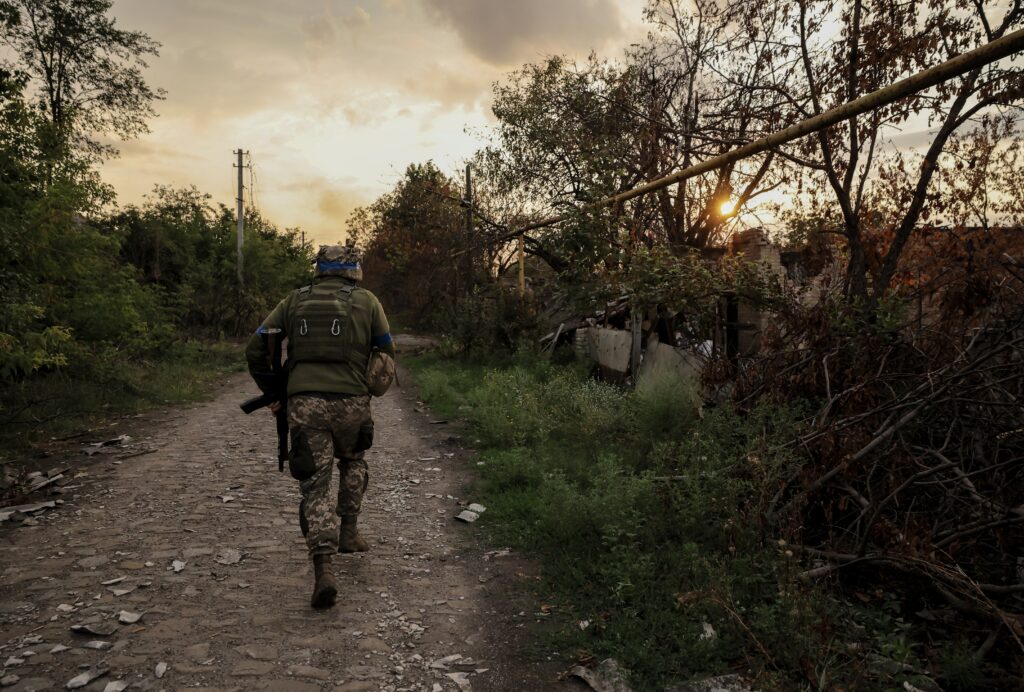MOSCOW — Russian forces were battling Ukrainian troops for a third day today after they smashed through the Russian border in the Kursk region, an audacious attack on the world’s biggest nuclear power that has forced Moscow to call in reserves.
In one of the biggest Ukrainian attacks on Russia of the two-year-old war, around 1,000 Ukrainian troops rammed through the Russian border in the early hours of Aug. 6 with tanks and armoured vehicles, covered in the air by swarms of drones and pounding artillery, according to Russian officials.
Heavy fighting was reported near the town of Sudzha, where Russian natural gas flows into Ukraine, raising concerns about a possible sudden stop to transit flows to Europe.
The incursion has come as a shock to Russia, nearly two-and-a-half years since President Vladimir Putin sent his army into Ukraine in February 2022.

CAUGHT WITH HIS PANTS DOWN: Russia’s Dictator Vladimir Putin speaks with Acting Governor of the Kursk region Alexei Smirnov via a video link outside Moscow, Russia August 8, 2024. Sputnik/Gavriil Grigorov/Kremlin via REUTERS
Putin has cast the Ukrainian offensive as a “major provocation”. Sergei Mironov, leader of a Kremlin-loyal political party, called it a “terrorist attack” and “the invasion of an internationally recognized foreign territory.”
Kursk’s regional acting governor, Alexei Smirnov, said that thousands of residents had been evacuated.
The White House said the United States – Ukraine’s biggest backer – had no prior knowledge of the attack. Washington has asked Ukraine for details on their military objectives, said a U.S. official, speaking on condition of anonymity, on Thursday.
“They are operating within the area north of the border where we have told them they can use U.S.-provided weapons to defend themselves against Russian attacks,” the official noted.
Russia’s defense ministry said today that the army and the Federal Security Service (FSB) had halted the Ukrainian advance and were battling Ukrainian units in the Kursk region.

An aerial view shows what is said to be a Russian army strike on Ukrainian ammunition concealed in the area bordering Ukraine in the Kursk Region, Russia, in this still image from video released August 8, 2024. Russian Defense Ministry/Handout via REUTERS
“Units of the Northern group of forces, together with the FSB of Russia, continue to destroy armed formations of the Armed Forces of Ukraine in the Sudzhensky and Korenevsky districts of the Kursk region, directly adjacent to the Russian-Ukrainian border,” the ministry said.
The Ukrainian military has remained silent on the Kursk offensive, though President Volodymyr Zelenskiy praised the Ukrainian army on Thursday for its ability “to surprise” and achieve results. He did not explicitly reference Kursk.
Some Russian bloggers said Ukraine’s forces were pushing towards the Kursk nuclear power station, which lies about 60 km (37 miles) northeast of Sudzha.
Yuri Podolyaka, a popular Ukrainian-born, pro-Russian military blogger, said that there were intense battles about 30 km (20 miles) from the Soviet-era nuclear plant, which supplies a large swathe of southern Russia with power.
CRITICAL JUNCTURE
Ukraine’s energy minister said gas transit via Sudzha was still functioning, despite reports of hostilities there. Most EU nations have reduced their dependence on Russian gas, but Austria is one country that still receives most of its gas via Ukraine.
The Center for Information Resilience, a non-profit open-source analysis organisation, said it was unable to visually confirm any damage to the gas metering station as a result of the incursion, but had verified significant damage to the border checkpoint about 500 metres (550 yards) to the south.
“This, combined with footage verified by CIR of several Russian soldiers surrendering to Ukrainian soldiers near the entrance of the gas metering plant, makes it likely that the plant has been affected by the Ukrainian incursion, however, the level of damage cannot be verified at this time,” it said.
The battles come at a crucial juncture in the conflict, the biggest land war in Europe since World War Two. Kyiv is concerned that U.S. support could weaken if Republican Donald Trump wins the November presidential election.
Trump has said he would end the war, and both Russia and Ukraine are keen to gain the strongest possible bargaining position on the battlefield.
Ukraine wants to pin down Russian forces, which control 18% of its territory, though the strategic significance of the border offensive was not immediately clear.
Former Russian President Dmitry Medvedev said the Ukrainian attack was an attempt to force Russia to divert resources from the front and to show the West that Ukraine could still fight.
As a result of the Kursk attack, Medvedev said, Russia should expand its war aims to include taking all of Ukraine.
“From this moment on, the SVO (Special Military Operation) should acquire an openly extraterritorial character,” Medvedev said, adding that Russian forces should go to Odesa, Kharkiv, Dnipro, Mykolayiv, Kyiv “and beyond”.
“We will stop only when we consider it acceptable and profitable for ourselves.”
By GUY FAULCONBRIDGE/Reuters
Guy Faulconbridge is Thomson Reuters’ Moscow bureau chief, who covers Russia and the Commonwealth of Independent States. Before Moscow, Guy ran Brexit coverage as London bureau chief (2012-2022). On the night of Brexit, his team delivered one of Reuters historic wins – reporting news of Brexit first to the world and the financial markets. Guy graduated from the London School of Economics and started his career as an intern at Bloomberg. He has spent over 14 years covering the former Soviet Union. He speaks fluent Russian.
Additional reporting by Eleanor Whalley in London, Anastasiia Malenko in Kyiv and Steve Holland in Washington; Editing by William Maclean and Jonathan Oatis
Our Standards: The Thomson Reuters Trust Principles



